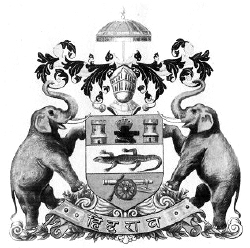SANDUR
 |
The Ghorpade Dynasty
BRIEF HISTORY
The modern state of Sandur was founded in 1713 by Sidhojirao of the Mahratta family of Ghorpade. At various times his descendants controlled large swaths of South-Central India. Murarirao, Sidhojirao's son held Gooty and surrounding territories, which stretched east to Madras and Pondicherry. He sided with Lord Clive and routed Chanda Sahib at the siege of Arcot.
The Peshwa Bajirao Raghunath II, having signed a treaty with the HEIC, demanded that Sandur be turned over to him, claiming that its ruler was a "recalcitrant vassal". The British obliged by securing his surrender in 1817. On closer inspection however, it was clear that they had been duped and the Ghorpades had been independent rulers of Sandur for a good many years. They restored the state to the Ghorpades after the deposition of the Peshwas in 1818 (confirmed in 1826).
The male line has failed several times, necessitating adoptions from junior branches of the family. The right to adopt an heir and successor was confirmed by a sanad of adoption in 1862.
The history of this small state was relatively uneventful, except for the progressive policies of its rulers during the late nineteenth and early twentieth centuries. The reforms in the administrative, judicial, political and social fields attracted attention, even amongst the Congress leaders. It was one of the first states to open places of worship irrespective of caste, outlaw "untouchability" and to establish educational institutions for all.
Raja Yeshwantrao signed the instrument of accession to the Dominion of India on 10th August 1947, and merged his state with Madras in 1949. After the redrawing of state boundaries on linguistic lines, it was transferred to Mysore in 1956. The Raja continued to play an active and influential role in public life, until his death in 1996. His son and successor as head of the family, Murarrao, served as an active politician for most of his life. Better known as "M.Y. Gorpade", he served as state Minister for Finance, Rural Development & Panchayats, MLA for Karnataka and MP of the Upper House of the Indian Parliament in New Delhi.
ARMS:
A fess, argent, thereon a "ghorpad" (monitor lizard) fesswise, proper; in the base, pink, a cannon, proper; in the chief, pink, a "Shiv Linga" vert, between two tower or. Helmet: with visor, all or. Crest: A "Chhatra" (parasol) on a wreath, all or. Supporters: Elephants with raised trunks, dexter, the rear left foot, and sinister, the front feet on the compartment, all proper. Motto: "Hindurao" in Marathi, azure on a pink riband. Compartment: Vines and creepers proper. Lambrequins: Argent and azure.
FLAG:
4x7 a rectangular swallow-tailed flag of saffron, with a white strip at the hoist, thereon in the centre; near the hoist, a golden sun in splendour of saffron rays with a "Ghoo" in the centre in natural colours, under a "Chhatra" of saffron with bistre spots.
STYLES & TITLES:
The ruling prince: Shrimant Maharaj Shri (personal name) (alias) (father's name) Ghorpade, Hindurao, Mamlukatmadar Senapati, Raja of Sandur.
The consort of the ruling prince: Shrimant Akhand Soubhagyavati Rani (personal name) Ghorpade, Rani Sahib of Sandur.
The Heir Apparent: Yuvraj Shrimant Shri (personal name) (alias) (father's name) Ghorpade, Yuvraj Sahib of Sandur.
The sons of the ruling prince: Rajkumar Shrimant (personal name) (alias) (father's name) Raje Sahib Ghorpade.
The unmarried daughters of the ruling prince: Rajkumari Shrimant (personal name) Raje Sahib Ghorpade.
The married daughters of the ruling prince: Shrimant Akhand Soubhagyavati (personal name) Raje (husband's family name).
ORDERS & DECORATIONS:
None.
RULES OF SUCCESSION:
Male primogeniture, with the right of adoption by the recognised head of the family, on the failure of natural male heirs.
SOURCES:
Chiefs and Leading Families in the Madras Presidency, First Edition, Madras Govt. Press, 1915.
M.Y. Ghorpade, The Grand Resistance: Murarirao Ghorpade and the 18th-Century Deccan. Ravi Dayal Publisher, Delhi, 1992.
History of the Ruling Princes, Chiefs and Leading Personages in the Madras States, Government of India Press, New Delhi, 1941.
SPECIAL ACKNOWLEDGEMENTS:
Rajkumar Shrimant Venkatrao Yeshwantrao Raje Ghorpade.
Father Lawrence Ober, SJ.